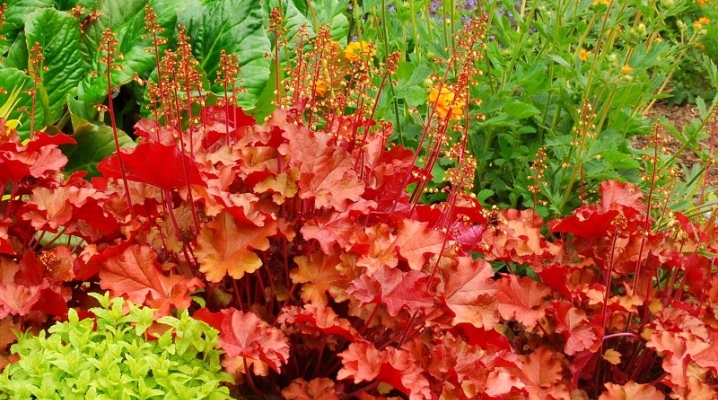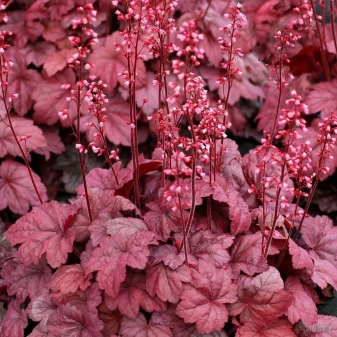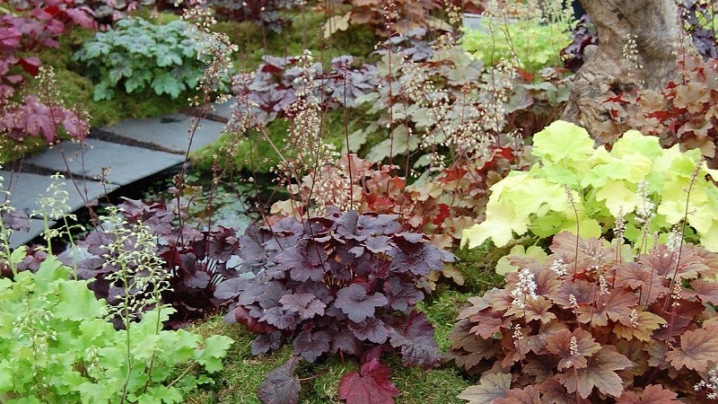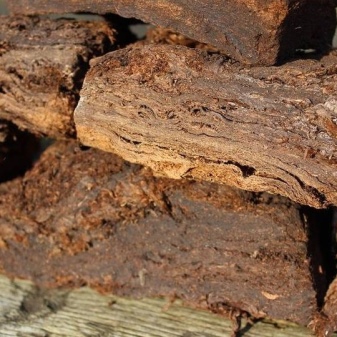Planting and caring for Heychera

Heuchera is a very beautiful plant belonging to the rhizome genus. This is a popular herbaceous perennial, varieties and varieties of which are in demand today in landscape design. An interesting plant has unusual leaves that can have a variety of shades. In this article, we will take a closer look at Heychera and find out how to take care of her according to all the rules.
Growing features
Geichera is extremely popular in our time. This plant looks like a small bush with well-grown greenery. The leaf blades of this green pet are distinguished by the fact that they have a serrated edge on their cuttings. Both the shape and color of the leaves can vary. In nature, you can find a large number of varieties, for example, those that have black leaf plates, but more often they are yellow, pink, burgundy (for example, the variety "Purple Castle", popularly called "red bell") or purple.
The plant in question is famous not only for its non-trivial appearance and variety of colors, but also for its unpretentiousness.


Growing such a garden dweller usually does not cause unnecessary trouble. Any florist will be able to provide this plant with proper care, without resorting to large time and money costs.
Despite the fact that heuchera is an undemanding plant, there are a number of features associated with its cultivation.
- It is imperative to get rid of the peduncles of the plant if you are growing an ornamental-deciduous variety. If you do not follow this rule, then they begin to rapidly rise above the flower, which makes it look awkward.
- Heuchera flower stalks are allowed to be left alone and not removed only if you want to get seed in the future.
- The lower leaf blades of this flower tend to fall off over time. To avoid bare and poor-looking stems, before flowering, you need to transfer the plant as carefully as possible to another, deeper place. At the same time, the roots should not be shaken off the ground.
- When growing geykhera on your site, you must take into account what is growing with them in the neighborhood. According to experienced flower growers, the best neighbors for these plants are primrose or astilba.
- This popular plant is usually planted in the spring, in March-April. Flowering should be expected with the onset of July-August.
- It is required to grow this unpretentious flower in conditions of light shading. Bright sunlight is not dangerous for geychera, but it must be diffused.
- Fertilizing a flower is allowed only from the second year of its growth. These procedures are carried out before the plant blooms, and then at the end of this process.
- As is the case with most other plants, growing heuchera, you need to monitor their health. These flowers are susceptible to a number of diseases that must be noticed in time and immediately treated. The same applies to parasites that can cause serious harm to Heuchers.
- The bush must be earthed. Without carrying out such procedures, the plant will inevitably begin to dry out. Sometimes such actions need to be repeated a couple of times a season.
- Over time, the leaf plates of the plant thicken and become darker, but at the very beginning (in the first months) they should be brighter and more transparent.


Timing
If you plan to grow unpretentious Heuchera flowers on your site, you should know at what time they need to be planted, fed, and at what periods they bloom:
- planting bushes must be carried out in March or April;
- flowering of plants occurs in summer - from June to August;
- you can start feeding a flower only from the second year, before and after flowering;
- if you plan to start propagating this flower by cuttings, then you need to carry out all the necessary procedures either in June or in July;
- wintering of these plants ends in spring, and all shelters previously used for protection must be removed from them;
- in the fall (at the very beginning) or in May, you can breed heuchera by dividing the bush.

Site selection and soil preparation
For planting the bushes in question, it is necessary to choose the most suitable place where the heuchers will feel comfortable. Sometimes it is difficult to select the optimal area for them, because adult plants do not tolerate growth in direct sunlight in the best way. - they are more adapted to life in the shade or partial shade. Young representatives, on the contrary, are completely unsuitable for such conditions; they should not be in shaded places.
If young plants are in a shaded area, then their growth will be slower, less productive. If you want to get really beautiful and spectacular bushes, then gardeners will have to wait a very long time.
These plants easily tolerate transplants and the procedure for dividing the roots, therefore, at first, it is recommended to plant and grow young growth in the sun, and then move mature specimens to partial shade. If you buy a flower with a well-developed root system, then you can immediately plant it in the shade.
If you are looking for the optimal place for young animals or seeds, then there is only one right solution - they must be planted in the sun.
It is important to take into account that young plants do not tolerate wind and drafts, so a place for them should be chosen where there is wind protection at least from the north side.

Varieties with lighter colored leaves will feel great if planted in sunny places. Darker specimens will grow better in shade.
No special soil is required for planting these plants. The main thing is that the soil has optimal acidity. Heuchera can be safely planted in the ground, the acid values of which are 6.0. It is allowed to plant flowers even in rocky soil, but in this case they will not be able to unfold in all their glory.
The optimal conditions for planting Heucher are loose and fertile soil. In such an environment, the development and growth of flowers will be full, fast. The moisture content of the soil should not be overshadowed. The earth must necessarily pass both water and air through itself without problems.
According to flower growers, geychers need soil that has undergone a liming procedure. Based on the acidity level, lime ash or dolomite flour can be used.
Heuchers are absolutely unsuitable for soils of heavy types. Plants can only be planted in light soils. These green pets also need good drainage. It can be built from chipped bricks or crushed stone of a large fraction.
The thickness of the drainage layer must be at least 5 cm.


Landing scheme
The plant in question can be planted both outdoors and at home. These procedures must be carried out correctly so as not to harm the seedlings.
Let's consider step by step how to properly plant the Heuchera.
- It is advisable to do this in the middle of spring. Seedlings can be purchased or obtained vegetatively.
- Plant stems will need to be trimmed down to young tissue. Shoots that could dry out must be cut to the level of live brood buds, which are usually located in the leaf axils.
- Next, you need to prepare the roots. To do this, remove any damaged, diseased or weak areas. Such elements of the roots must be removed completely, and the cuts after that require processing with crushed charcoal.
- Landing is best done in squares, or in a checkerboard pattern. A gap of at least 50-60 cm must be left between the flowers.
- Under each of the bushes, you need to dig a hole with a depth and diameter of 30 cm.A drainage layer should be laid out on its bottom, and covered with a layer of soil about 5 cm on top.
- After that, organic or mineral fertilizers must be added to the soil.
- A young seedling should be installed in the central part of the hole, and covered with soil. After that, the soil must be slightly compacted and watered with 3-5 liters of water.
- For the first couple of days, it is advisable to slightly shade the plant, but in the future, protection from direct rays of the sun can be removed.


How to care?
Heuchers, like any other garden plants, need proper and regular care. Without it, the flowers will not grow beautiful, they can become seriously ill and even die. Let's consider in detail how to care for these adorable creatures.
Watering
It is important to water geykhera regularly and in a timely manner. The condition of the plants will depend on proper watering, so these procedures cannot be neglected.
The crops under consideration need to be watered once every two days after the top soil layer has dried. Heuchera refers to the category of flowers that survive drought many times better than stagnant moisture in the root system. However, during prolonged hot and sultry days, watering will be required 2 times a day - early in the morning and late in the evening.
Perennials should be watered as carefully as possible. The liquid should flow exclusively under the roots of the plants. Drops should never end up on the sheet plates, as this can lead to serious burns.
In order not to encounter constant weeding and regular loosening, in the spring, upon completion of irrigation, the soil surface must be sprinkled with a layer of mulch (peat).

Top dressing
Heuchera needs proper feeding. They need to be made at certain times. In the first year after planting, there is no need to feed a perennial bush. In the future, fertilizers are required to be applied annually during the growing season. If you are engaged in the cultivation of decorative deciduous varieties, then as top dressing it is necessary to use complex mineral compositions intended for deciduous crops.
If you grow ornamental flowering varieties of geyher on your house plot, then you can buy universal fertilizers for flowering plants for them.
Top dressing is required to be applied to the soil where the flowers grow, twice during the season - before and after flowering. In this case, it is required to use only half the dosage stated by the manufacturer.


Wintering
Geykhera can perfectly winter in the open field, which is why it is so popular in our country, and it can be safely grown not only in the Moscow region, but also in more severe climatic conditions, the main thing is proper preparation. In the fall, yellowed and dried leaves should not be cut off from a perennial, since they serve as protection against the destructive freezing of the plant's root system in winter. For the winter, it is recommended to properly cover the geyher. As a good shelter, flown oak foliage is perfect here.
With the onset of spring, the covering material must be removed, and the old leaves from the bush must be cut as accurately as possible using a pruner. Slices should be made as close to the surface of the site as possible.


How to transplant?
Heuchera flowers should be transplanted in the spring or if necessary - for example, when the bushes need a change of soil, or the old pot has become cramped. Here it is important to observe the planting depth, or place the bushes in such a way that they are slightly deeper than the level at which they were in the previous case.
If there are no hints of rot or other dangerous diseases on the plant, then instead of transplanting, you can resort to transshipment of bushes. They just need to be transferred to a new pot along with the old earthy clod. Such a procedure will turn out to be completely non-traumatic for the roots of the flower, it will quickly adapt to new conditions and grow.
If there is a suspicion that root rot is taking place, then the flower must be transplanted with an absolute substitution of the substrate. In this case, the roots need to be thoroughly disassembled, carefully examined. Rotten and old roots should be cut off with a sharp pruner, and areas with cuts should be treated with special fungicidal agents, sprinkled with powdered charcoal.


Transplantation of previously diseased plants can be carried out exclusively into a fresh substrate, because pathogens of the disease may still remain in the old one. After transplanting, the soil will need to be tamped with your fingertips so that air pockets do not appear. After carrying out these procedures, you can not water the flower for several days, as well as expose it to the sun.
Heuchera transplant is also necessary if you are engaged in its reproduction by division. Of course, these procedures are easier for experienced flower growers, but beginners can also do them, following some simple rules.
- The division of the bushes can be carried out in autumn or spring, every 3-4 years. This is how the plant rejuvenates and reproduces. Otherwise, the flower may become bald.
- Early fall or late spring is the ideal time for planting.
- The bush must be very carefully dug up, and then divided into 2-3 parts.
- Next, you need to take a knife, carefully cut the rhizomes into approximately equal parts. It is advisable to save the soil on the roots so that the seedlings can quickly take root in a new place.
- The sprouts should be planted according to the usual scheme, not forgetting about abundant watering.
The suitable size of the hole for planting the separated part is 20x30 cm. Between the transplanted bushes, a distance of at least 25 cm should be maintained.After the planting process is completed, it is necessary to water the flower, and also mulch the space around the trunks.
A new, separated and transplanted bush will gain strength over the next month.


Diseases and pests
As mentioned earlier, Heucheras are susceptible to certain diseases, like any other culture. But it should be noted that the plants in question are more resistant to the effects of various diseases and parasites. Despite the excellent immunity, Heucheras sometimes suffer from such serious ailments as rust, spotting, powdery mildew, and sulfur rot. Usually, such problems arise due to the fact that a lot of excess moisture stagnates in the rhizomes of the flower, or there is an excess of applied fertilizers in the soil.
If a characteristic whitish bloom has formed on the leaf blades of a flower, this indicates that it is affected by powdery mildew. To rid the plant of this serious ailment, you will need to turn to treatment with special fungicidal compounds.
If heuchera have become victims of rust or spotting, then they will need to be sprayed with a Bordeaux mixture solution every couple of weeks.


There are parasitic insects that can cause serious damage to the health of Heuchera. Here is some of them:
- slugs;
- caterpillars;
- snails;
- weevils;
- leaf nematodes.
To destroy the listed pests, the bush must be carefully treated with a specialized insecticidal preparation.
If you notice that the plant is sick or has become a victim of pests, then do not waste time. All effective actions must be taken as soon as possible to save the flowers.Otherwise, time may be lost, and perennials will simply die.


Helpful hints
If you decide to grow Heuchera yourself, then you should take on board some useful tips from experienced florists.
- If you are separating a perennial bush, you need to sanitize it. To do this, it will be necessary to remove too long, dry and damaged roots from the root system of the plant.
- When the flowering of heuchera is in full swing, it cannot be fed.
- It is necessary to ensure that excess liquid does not stagnate in the roots of the plant. Do not underestimate such an omission, as this will subsequently lead to rotting of the roots, disease of the flower and even its death.
- If you do not want to bother with removing weeds and loosening the soil after watering, then it is worth mulching the planting of heuchera in the spring using peat.
- It is not recommended to water this plant with a hose, as such procedures can cause serious harm. Water must be at room temperature.
- It is strongly not recommended to plant Heuchera in lowland conditions or in places where there is a high level of groundwater. Excessive soil moisture will have a bad effect on the condition of the plant root system.
- Before planting heuchera seeds, it is important to properly heat the soil. Thus, it will be possible to destroy all the fungi that are in it. To do this, you will need to douse the earth with boiling water or place it in an oven with a set temperature of +110 degrees for 30 minutes. Next, the soil will need to be dried within 24 hours, and only after that start planting seeds.
- Heuchera seedlings for further transplanting into the ground need a correct pick. You can resort to it when the first 3 leaves have appeared on the sprouts. Seedlings are required to dive at a distance of 4-6 cm between them. This procedure is necessary to maintain a moderately moist soil condition.
- Geyher pruning should be done at the very beginning and at the end of the season.
- Cutting off too old, diseased and previously injured leaf plates is recommended in early spring. At the same time, you should make a formative and stimulating pruning of the entire bush as a whole.
- When loosening, one must remember that the main thing in the procedure is to cover the sockets in order to prevent them from frostbite or drying out.
- If desired, heuchera can be used to make borders or spectacular flower beds, since this plant tends to retain its shape.
- Heuchera is allowed to combine with various dwarf shrubs on the site. Combinations with badan, primroses, brunner, astilba are quite good.
- If you notice that the flowers are suffering from any disease, but do not know how to cure it, then it is better to seek help from experienced florists. It is not worth experimenting with culture, because this can lead to bad consequences.
- If you plan to plant Heucheras with seeds, then it is worth considering that they are usually very small in size, so to get more uniform shoots, they can be mixed with sand. For the same reason, there is no need to deepen the seeds too deeply into the ground.
- When replanting Heuchera, you must be as careful and careful as possible. Special care should be taken with the root system of flowers - they should not be damaged, as this will affect them destructively.


In the next video, you will find additional information on planting and caring for the Heuchera.







































































































The comment was sent successfully.